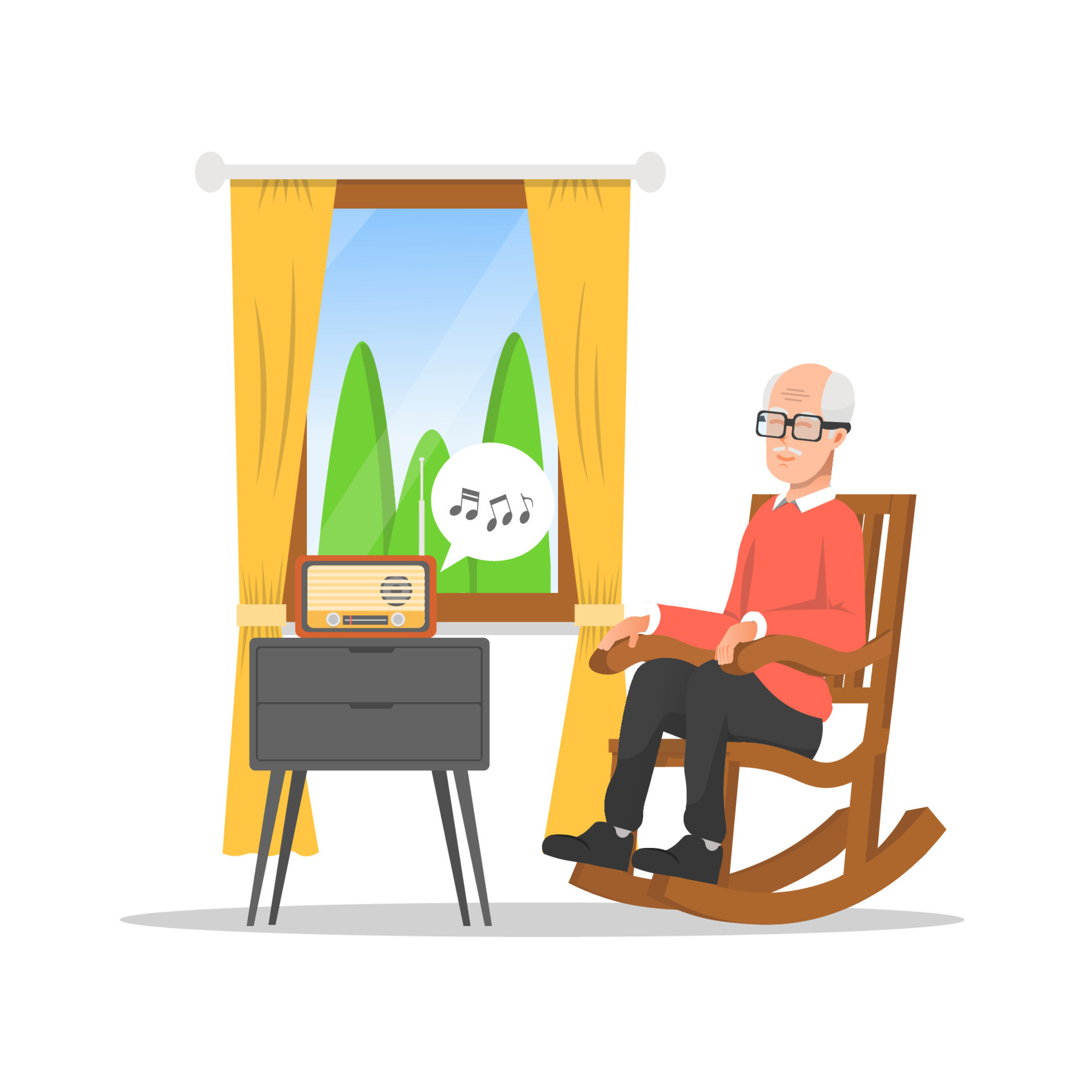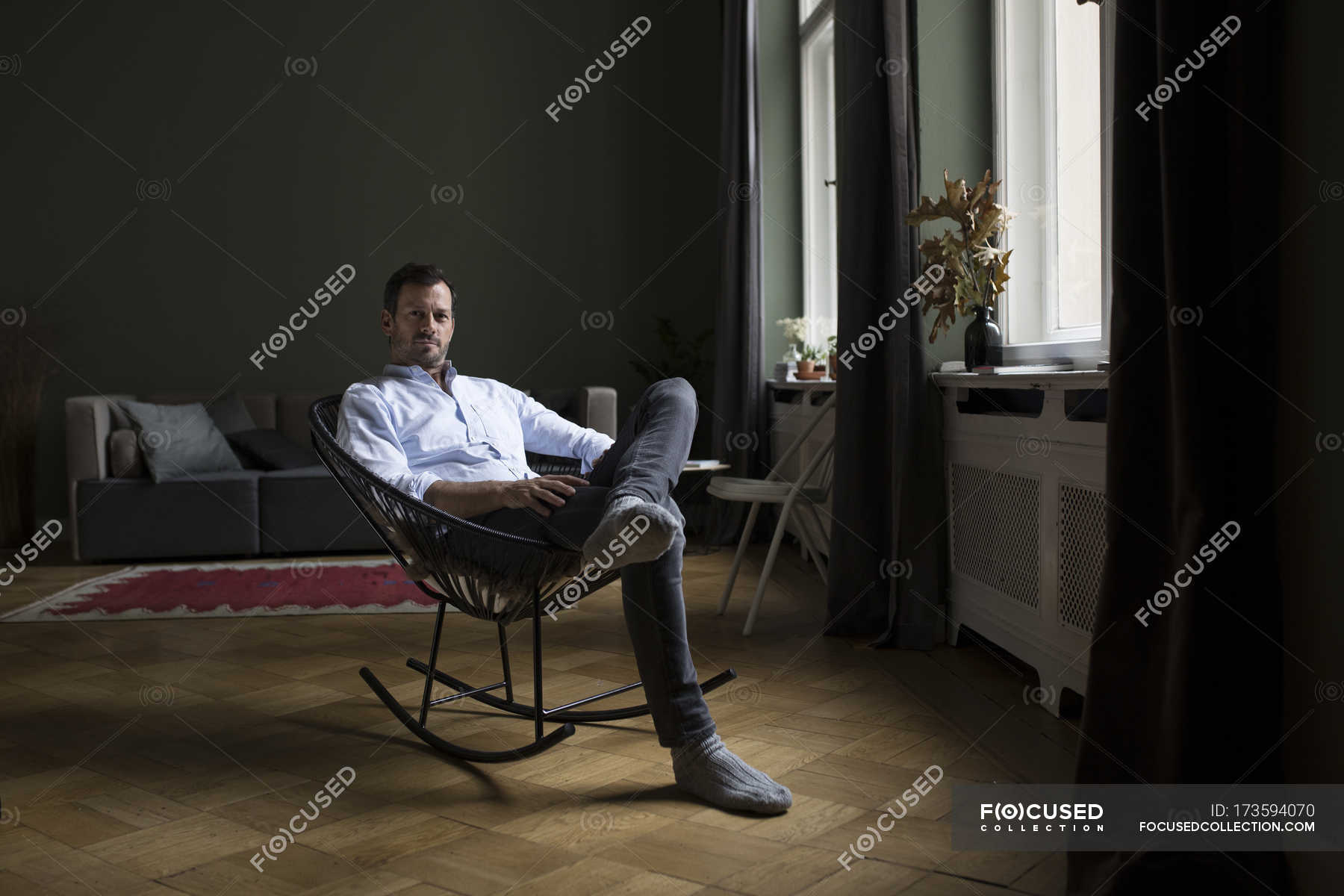The Symbolism of the Rocking Chair

The rocking chair, a seemingly simple piece of furniture, holds a rich history and symbolism that transcends its practical function. It has become an enduring icon of comfort, contemplation, and the passage of time, deeply ingrained in the cultural fabric of various societies.
Historical Significance
The rocking chair’s origins can be traced back to the 18th century in America, where it was initially a practical invention for easing the discomfort of long hours spent on horseback or in carriages. The rocking motion provided a gentle, rhythmic movement that helped alleviate back pain and fatigue. However, the rocking chair quickly evolved beyond its utilitarian purpose and became a cherished symbol of domesticity and leisure.
Symbolism of Relaxation and Contemplation, Man on rocking chair
The gentle rocking motion of a rocking chair has a calming effect, fostering a sense of relaxation and tranquility. The rhythmic back-and-forth movement creates a soothing environment conducive to contemplation and introspection. This association with relaxation and contemplation has been reinforced by its presence in countless literary works and artistic representations.
Symbolism of Aging
The rocking chair has also become inextricably linked to the concept of aging. In popular culture, it is often depicted as a piece of furniture reserved for the elderly, symbolizing a time of reflection and reminiscence. The rocking chair becomes a physical embodiment of the life lived, with each creak and sway whispering tales of the past.
Portrayal in Literature and Art
The rocking chair has been a recurring motif in literature and art, capturing its symbolic significance.
- In Mark Twain’s The Adventures of Tom Sawyer, Aunt Polly sits in a rocking chair on the porch, a classic image of a nurturing and wise matriarch.
- The rocking chair features prominently in Thornton Wilder’s play Our Town, where it represents the simple joys and quiet moments of everyday life.
- In painting, the rocking chair has been used to depict a range of emotions and themes. For example, in Winslow Homer’s The Old Man and the Sea, a solitary figure sits on a rocking chair, contemplating the vastness of the ocean, reflecting on the passage of time and the cyclical nature of life.
The Physical and Psychological Benefits of Rocking

Rocking, a simple yet profound motion, has been a part of human experience for centuries. From cradles to rocking chairs, this rhythmic movement holds a unique appeal that transcends generations. While its comforting presence is undeniable, rocking offers a range of physical and psychological benefits that are worth exploring.
The Physical Benefits of Rocking
Rocking provides a gentle form of exercise that can benefit people of all ages and abilities. The rhythmic back-and-forth motion engages various muscle groups, promoting strength, flexibility, and coordination.
- Improved Balance and Coordination: The constant shifting of weight during rocking helps strengthen the muscles responsible for balance and coordination. This is particularly beneficial for older adults who may experience age-related decline in these areas.
- Enhanced Circulation: Rocking stimulates blood flow throughout the body, improving circulation and oxygen delivery to muscles and organs. This can help reduce muscle fatigue and improve overall cardiovascular health.
- Increased Range of Motion: The gentle rocking motion can help increase flexibility and range of motion in the hips, knees, and ankles. This is particularly beneficial for individuals who have limited mobility or are recovering from injuries.
The Psychological Benefits of Rocking
Beyond its physical benefits, rocking also has a profound impact on our mental and emotional well-being. The rhythmic motion has a calming effect on the nervous system, promoting relaxation and reducing stress.
- Stress Reduction: The repetitive and predictable nature of rocking can help to calm the mind and reduce feelings of anxiety and stress. This is because rocking stimulates the release of endorphins, which have mood-boosting effects.
- Improved Sleep: Rocking can help to promote relaxation and improve sleep quality. The rhythmic motion can help to slow down the heart rate and breathing, preparing the body for sleep.
- Emotional Regulation: Rocking can be a powerful tool for emotional regulation. The gentle swaying motion can provide a sense of security and comfort, helping to soothe feelings of sadness, anger, or anxiety.
Rocking in a Chair vs. Other Forms of Movement
While rocking in a chair is a unique and beneficial form of movement, it is important to compare and contrast it with other forms of exercise.
- Rocking vs. Walking: Walking provides a more vigorous form of exercise that can improve cardiovascular health and endurance. However, rocking can be a gentler option for individuals who are unable to walk or who prefer a less strenuous activity.
- Rocking vs. Yoga: Yoga focuses on stretching and strengthening the body through a series of poses. While rocking does not offer the same level of flexibility or strength training, it can provide a calming and restorative experience.
- Rocking vs. Meditation: Meditation involves focusing the mind on a single point, such as the breath. Rocking can be a complementary practice, providing a gentle physical movement that can enhance relaxation and mindfulness.
The Rocking Chair in Contemporary Culture: Man On Rocking Chair
The rocking chair, once a symbol of leisurely afternoons and quiet contemplation, has undergone a transformation in contemporary culture. While it retains its traditional appeal, the rocking chair has also found new life in modern homes, public spaces, and even in the realm of design. Its versatility and enduring charm have made it a fixture in diverse settings, reflecting a shift in how we perceive and use this iconic piece of furniture.
Contemporary Uses of Rocking Chairs
The rocking chair’s adaptability is evident in its diverse applications in contemporary settings. Beyond the traditional image of a rocking chair on a porch, it has become an integral part of modern homes, gardens, and public spaces.
- Homes: Rocking chairs are no longer confined to specific rooms. They are found in living rooms, bedrooms, and even home offices, providing a comfortable and calming presence. The rhythmic motion of rocking can be a soothing element in any space, fostering a sense of relaxation and well-being.
- Gardens: Rocking chairs have become a popular addition to outdoor spaces, providing a tranquil spot to enjoy the serenity of nature. They are often placed on patios, decks, or under trees, creating a peaceful haven for reading, contemplation, or simply enjoying the fresh air.
- Public Spaces: Rocking chairs are increasingly seen in public spaces, such as libraries, waiting rooms, and even cafes. They offer a comfortable alternative to traditional seating, encouraging a sense of relaxation and promoting a more welcoming atmosphere.
Modern Interpretations of the Rocking Chair
The rocking chair’s enduring popularity has inspired contemporary designers to create innovative and stylish interpretations. Modern rocking chairs often incorporate contemporary materials, such as metal, glass, and sustainable wood, while retaining the iconic silhouette.
- Minimalist Designs: Contemporary rocking chairs often feature clean lines, simple shapes, and a focus on functionality. They may incorporate materials like stainless steel or polished wood, creating a sleek and modern aesthetic.
- Sculptural Forms: Some contemporary rocking chairs are designed to be more than just functional pieces of furniture. They are crafted with a focus on form and aesthetics, resembling works of art. These chairs may feature intricate curves, bold colors, or unique materials, adding a touch of artistry to any space.
- Sustainable Materials: In line with the growing trend towards eco-consciousness, many contemporary rocking chairs are made from sustainable materials, such as reclaimed wood or bamboo. These chairs not only offer a stylish and functional design but also contribute to environmental sustainability.
The Rocking Chair in Various Settings
The rocking chair’s versatility is evident in its ability to seamlessly integrate into a wide range of settings. From cozy living rooms to serene gardens, rocking chairs offer a touch of comfort and elegance.
“The rocking chair is a symbol of tranquility and a reminder of simpler times.” – Unknown
Man on rocking chair – The image of a man on a rocking chair evokes a sense of tranquility and leisure, a moment of respite from the daily grind. However, extended periods of sitting can lead to discomfort, particularly for those seeking a heightened level of comfort.
To address this, specialized accessories such as kennedy rocker chair pads have been designed to provide enhanced support and cushioning, transforming the rocking chair experience into one of pure relaxation and enjoyment.
The image of a man in a rocking chair evokes a sense of tranquility and leisure. This quintessential symbol of relaxation can be further enhanced with the addition of jumbo rocking chair cushion sets , providing unparalleled comfort and support.
These plush cushions transform the rocking chair into a haven of indulgence, allowing the individual to fully immerse themselves in the moment and experience the profound benefits of a well-deserved respite.

